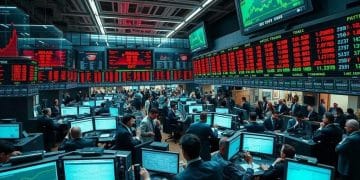Market rebounds after easing global trade tensions

Market rebounds after easing global trade tensions create opportunities for investors through diversification and increased confidence, significantly impacting economic growth and the role of emerging markets.
Market rebounds after easing global trade tensions is a topic that’s been on the lips of many analysts recently. With signs of recovery, it begs the question: what does this mean for our finances and investments?
Understanding global trade tensions
Understanding global trade tensions is crucial for anyone interested in international markets. These tensions often arise from disputes between countries over tariffs, trade agreements, and import-export regulations.
Causes of Global Trade Tensions
Several factors can lead to these disputes. Economic interests of nations often clash, resulting in trade barriers or sanctions. When countries feel threatened economically, they may take actions that escalate tensions.
- Tariff increases on imported goods
- Political disagreements impacting trade policies
- Supply chain disruptions affecting global commerce
- National security concerns prompting protective measures
Each of these elements can cause markets to react unpredictably. When trade tensions spike, investors often panic, leading to volatile changes in stock prices. It’s vital to stay informed about these developments to anticipate market movements.
Impact on the Economy
The effects of trade tensions can be widespread. Industries that rely on imports may face increased costs, which can lead to higher prices for consumers. This, in turn, may slow down economic growth.
Additionally, when countries engage in trade disputes, it can lead to a ripple effect. Global supply chains become strained as companies adapt to changing tariffs. This higher volatility in pricing makes planning difficult for businesses, driving some to seek alternative markets or suppliers.
As a result, understanding these factors helps investors make more informed decisions about where to allocate resources during turbulent times. Keeping an eye on negotiations between countries can also provide insights into potential market rebounds.
How easing tensions impact markets

How easing tensions impact markets is a topic that many investors are keen to understand. When global trade disputes begin to settle, there are often immediate and positive effects on market stability.
Immediate Market Reactions
Typically, when trade tensions decrease, markets respond favorably. Investor confidence grows, and this can lead to a surge in stock prices. Companies that were previously affected by tariffs may see a boost in earnings as trade barriers are lifted.
- Stocks often rise due to increased investor sentiment.
- Economic forecasts improve as stability returns.
- Foreign investments increase with a more favorable trade environment.
- Consumer spending can potentially increase due to lowered product prices.
As the atmosphere becomes more favorable for trade, it’s crucial to recognize which sectors benefit the most. For instance, industries heavily reliant on exports often experience significant gains when tensions ease.
Long-term Effects on Businesses
The long-term effects of easing trade tensions can be equally beneficial. Businesses may start to expand operations or invest in new projects, driven by increased demand and reduced costs. This cycle fosters economic growth and job creation.
Furthermore, a stable trade environment encourages companies to innovate. With fewer uncertainties, businesses are more likely to allocate resources for research and development. This focus on innovation can lead to new products, improving the competitive landscape.
Ultimately, the easing of trade tensions can serve as a catalyst for recovery in markets worldwide. It not only positively affects businesses but also boosts overall economic health.
Investor strategies in a recovering market
Investor strategies in a recovering market are essential for maximizing potential gains. Understanding how to navigate these times can lead to better investment decisions and increased profits.
Diversification is Key
During a recovery, it is vital to diversify your investment portfolio. Relying too heavily on one type of asset can be risky. By spreading investments across different asset classes, you can mitigate potential losses.
- Stocks in various sectors
- Bonds for stability
- Real estate for potential appreciation
- Commodities like gold for hedging
In a recovering market, sectors such as technology and consumer goods often see rapid growth. Keeping a mix of these investments can help balance your risk.
Stay Informed and Agile
Investors must stay informed about economic trends and market news. In a recovering market, this information is critical. Quick reactions to changes can maximize returns. When you see positive news about economic indicators like job growth or rising consumer confidence, it may be time to invest more heavily.
Additionally, setting specific goals and regularly reviewing your strategies can help you stay on track. Adjusting your portfolio based on market conditions ensures that you are taking advantage of new opportunities.
Moreover, patience is vital. Recovery can take time, and jumping in and out of investments can be detrimental. A steady approach can yield better long-term results and reduce stress.
Future outlook for global trade dynamics

The future outlook for global trade dynamics is shaped by emerging trends and geopolitical factors. As we move forward, understanding these elements is essential for businesses and investors alike.
Emerging Markets Expansion
As economies grow, emerging markets are likely to play a bigger role in global trade. Countries in Asia, Africa, and Latin America are witnessing rapid development, which can increase their trade activities. These regions often offer new opportunities for investment.
- Increased demand for goods and services
- Growth in manufacturing capabilities
- Technological advancements driving efficiency
- Trade agreements fostering collaboration
With these changes, established markets must adapt to remain competitive. This can lead to exciting innovations and better products for consumers globally.
Technological Innovations
The integration of technology into trade practices will significantly shape the future. Automation and digital platforms are streamlining operations, making trading processes faster and more efficient. Blockchain technology and advanced logistics solutions are pivotal in enhancing transparency and reducing costs.
Moreover, artificial intelligence can provide insights into market trends, enabling businesses to make informed decisions quickly. As technology progresses, it will further transform the dynamics of global trade.
Trade policies will also evolve, focusing more on sustainability and ethical practices. Companies that prioritize these factors may gain a competitive edge, reshaping consumer expectations along the way.
FAQ – Frequently Asked Questions about Market Recovery and Global Trade Dynamics
What are the main strategies for investors in a recovering market?
Investors should focus on diversification, stay informed about market trends, and be patient with their investment choices.
How do emerging markets influence global trade?
Emerging markets expand opportunities with increasing demand and growth potential, often driving innovation and competition.
Why is technology important in global trade dynamics?
Technology enhances efficiency, transparency, and decision-making, allowing businesses to adapt quickly to market changes.
What should investors consider regarding sustainability in their investments?
Investors should align with businesses that prioritize sustainable practices, as these companies are increasingly favored in the market.





